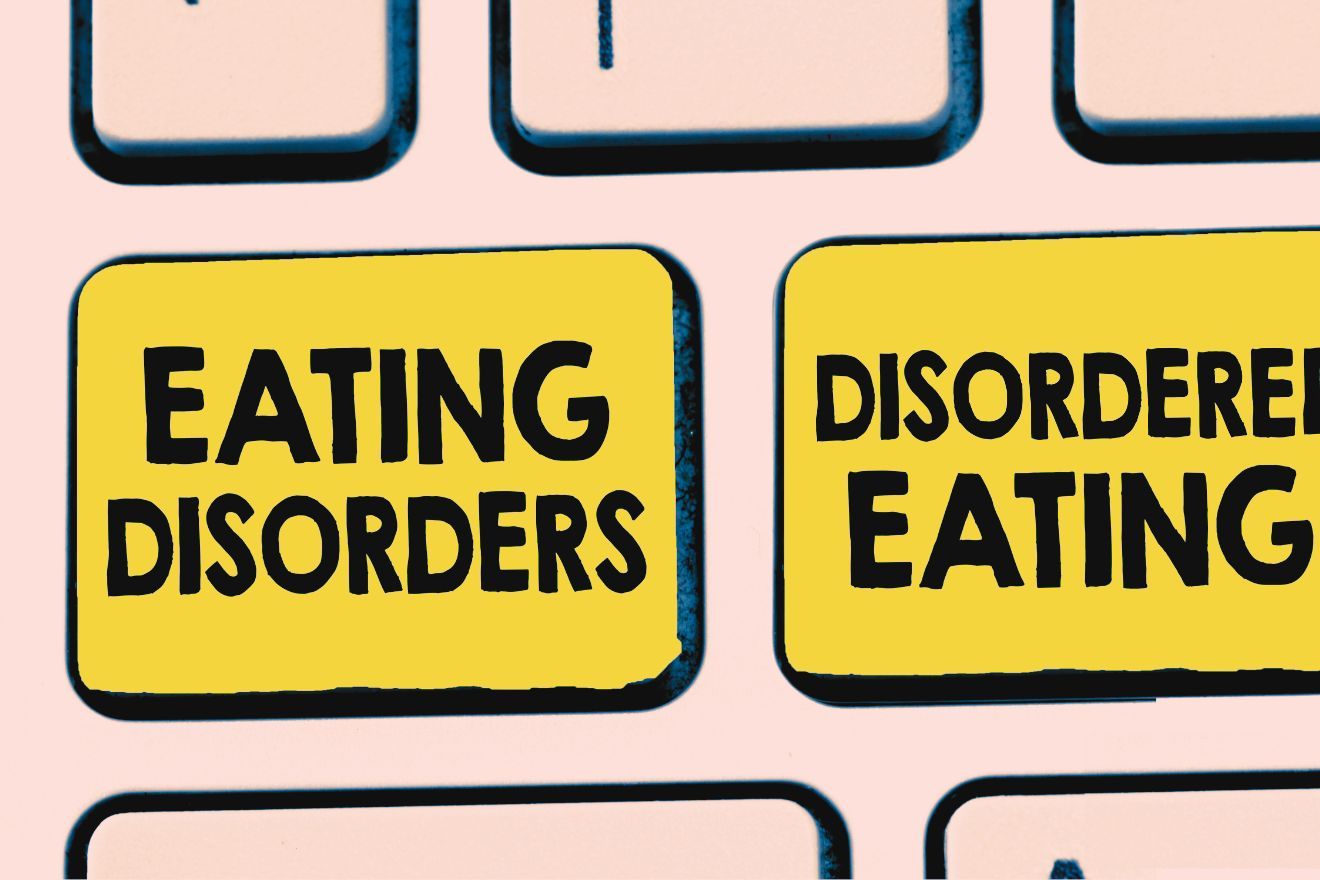If you spend a couple of minutes online looking at health and fitness sites, you will notice one thing immediately. There is a vast amount of information that explains how to lose weight, what diets to follow, and exercise programs to get proven results. “Before and after” photos get all the likes, clicks, and views. People believe there are two types of food: good and bad or clean and unclean.
Our culture values thinness and equates six-pack abs with health. Hence, yo-yo dieting, obsessing over calories, avoiding carbs, only eating protein, skipping meals, taking diet pills, and doing restrictive cleanses are normalized in society.
Unfortunately, these social conditions have made it difficult to determine whether a person is merely making a change to improve their health or if something more concerning is going on.
This article dives into the key differences between disordered eating and an eating disorder.
You can learn more by reading our eating disorders blog series:
Part 1: 3 Most Common Types of Eating Disorders
Part 2: Why Someone Who Looks Healthy May Have An Eating Disorder
Part 3: Disordered Eating Isn’t The Same as an Eating Disorder
Part 4: Psychedelics and Their Potential for Treating Eating Disorders
What is Disordered Eating?
Disordered eating is when an individual engages in abnormal eating behaviors such as limiting food groups and eating pleasurable foods to deal with difficult emotions. Some other examples of irregular eating behaviors include the following:
- Emotional eating or consuming food to cope with negative emotions such as sadness, loneliness and boredom
- Stress eating or eating for reasons not related to hunger or nutrition
- Refraining from eating major food groups
- Only eating from a major food group
- Binge eating
- Binging and purging episodes with compensatory behaviors on an infrequent basis
- Weight fluctuations
- Labeling foods as “clean or good” and “unclean and bad”
- Extreme dieting
- Feeling guilt or shame for eating certain “bad” foods or overeating
- Taking diet pills and/or using laxatives, diuretics and enemas to lose weight
- Forcing themselves to throw up after binging
- Doing cleanses to compensate for overeating
- Eating the exact same thing every single day
- Extreme dieting with an “all or nothing” approach
- Creating many unrealistic rules or a ritual to follow in regard to food
- Skipping meals
- Exercising excessively to compensate for large meals or binge episodes
Emotional eating has become socially acceptable to deal with stress or an upsetting day. For instance, it’s common to see a movie character reach for a tub of ice cream to feel better after a horrible breakup. Food companies promote their products as something people can rely on to add pleasure to their day. There’s a reason why fries, mac and cheese and pizza are often referred to as comfort foods. This creates challenges for an individual to recognize their disordered pattern of eating as a harmful behavior and how it negatively affects their mental, emotional, and physical well-being.
Unfortunately, when someone constantly turns to food as a way to numb their painful feelings, it can become an unhealthy coping mechanism and lead to disordered eating behavior as well as an increased risk of developing health complications. For example, disordered eating has been shown to lead to bone loss due to nutritional deficiency, obesity, metabolic problems, eating disorders, gastrointestinal issues such as constipation or diarrhea, low heart rate, muscle cramps, poor sleep quality, headaches, social isolation, low blood pressure and increased symptoms of anxiety and depression.
What is an Eating Disorder?
An eating disorder is a complex disorder characterized by pathological eating habits and abnormal attitudes towards food that harms a person’s health and negatively impacts a person’s ability to function normally. Common types of eating disorders are binge eating disorder, anorexia nervosa and bulimia nervosa. You can learn more about these eating disorders here.
Signs a person may have an eating disorder include the following:
- Body image issues
- Extreme fear of gaining weight
- Low self-esteem
- Always feeling cold and wearing many clothes to keep warm
- Practicing extremely restricted diets
- Refusing to eat in social settings with other people around
- Eating secretly and hiding food wrappers
- Hoarding food
- Eating by themselves always
- Wearing loose clothing to make their weight loss less visible
- Feelings of anxiety and depression
Key Differences Between Disordered Eating and Eating Disorders
Disordered eating and eating disorders share similar symptoms and irregular eating behaviors; however, it is important to understand the key differences between the two so that individuals can seek appropriate treatment for their condition. Here are some of the key differences between the two.
Diagnosis
When referring to a clinical diagnosis, disordered eating does not meet the diagnostic criteria for a mental health disorder.
Therefore, someone who engages in disordered eating may not necessarily be diagnosed with an eating disorder. However, a person with an eating disorder may have disordered eating behaviors.
Frequency and Severity of Symptoms
The main difference between disordered eating and an eating disorder involves how often and how intense their symptoms are. Both conditions share symptoms; however, the severity and frequency of symptoms are less for disordered eating compared to an eating disorder.
A person struggling with an eating disorder is obsessed with food and their body size. Counting calories and thinking about how to change their body shape or weight consumes their day. They have trouble focusing on anything else. They exhibit significant weight changes in short periods of time. They have a deep, intense fear of gaining weight or getting fat and a distorted view of their body. They completely tie their self-worth to how their body looks.
A person with disordered eating may have the same thoughts and behaviors but they occur on a limited-time basis and they do not engage in them at the same level as someone with an eating disorder. Although the symptoms are less severe for someone with disordered eating, it doesn’t mean it is not a serious condition. Disordered eating can lead to the development of an eating disorder.
Impact on Normal Daily Functioning
Another main difference between disordered eating and an eating disorder is how it affects a person’s day. It may indicate an eating disorder if the individual’s eating habits prevent them from engaging in normal activities of daily living.
For instance, if they are missing work or school because they feel compelled to spend the day at the gym or if counting calories or thoughts about food have created issues for them to do their household routines. Another example would be if they are avoiding seeing their friends because they are afraid they will judge what and how they eat.
Therefore, disordered eating is not the same as an eating disorder; however, both conditions can lead to negative health consequences.
A mental health professional can help you understand your beliefs and past traumas around food and body image issues, overcome abnormal eating habits and develop a healthy relationship with your body and food. Find a clinic or therapist near you or online in our leading vetted therapy directory.
If you or someone you care about may be struggling with an eating disorder, contact the National Eating Disorders Association (NEDA) Helpline for support, resources, and treatment options at 1–800–931–2237. They have text, online chat, and phone call options.
Follow your Curiosity
Sign up to receive our free psychedelic courses, 45 page eBook, and special offers delivered to your inbox.References
Academy of Nutrition and Dietetics. (2020, February 28). What Is Disordered Eating. Retrieved from www.eatright.org: https://www.eatright.org/health/health-conditions/eating-disorders/what-is-disordered-eating
American Psychological Association. (2020, February 25). Eating disorders. Retrieved from www.apa.org: https://www.apa.org/topics/eating-disorders
Ekern, B. (2016, February 19). Disordered Eating vs. Eating Disorders: What is the difference? Eating Disorder Hope. Retrieved from https://www.eatingdisorderhope.com/blog/eating-disorders-disordered-eating
Guarda, A. (2021, March). What Are Eating Disorders? Psychiatry.org; American Psychiatric Association. Retrieved from https://www.psychiatry.org/patients-families/eating-disorders/what-are-eating-disorders
National Eating Disorders Collaboration. (n.d.). Disordered Eating & Dieting. Nedc.com.au. Retrieved from https://nedc.com.au/eating-disorders/eating-disorders-explained/disordered-eating-and-dieting
Ortega-Luyando, M., Alvarez-Rayón, G., Garner, D. M., Amaya-Hernández, A., Bautista-Díaz, M. L., & Mancilla-Díaz, J. M. (2015). Systematic review of disordered eating behaviors: Methodological considerations for epidemiological research. Revista Mexicana de Trastornos Alimentarios, 6(1), 51–63. https://doi.org/10.1016/j.rmta.2015.06.001
Pennesi, J.-L., & Wade, T. D. (2016). A systematic review of the existing models of disordered eating: Do they inform the development of effective interventions? Clinical Psychology Review, 43, 175–192. https://doi.org/10.1016/j.cpr.2015.12.004
Zucker, T. (2017, May 22). Eating Disorders vs. Disordered Eating: What’s the Difference? National Eating Disorders Association. Retrieved from https://www.nationaleatingdisorders.org/blog/eating-disorders-versus-disordered-eating







